Trifolium pratense
In researching this article, I came across a translation of Red Clover’s Latin name as “three leaf growing in meadows.” Which is lovely. (Latin is nowhere near as stodgy as we are made to believe!) But, in trying to confirm the translation, I found something different. The Latin word “pratense” means “speaking.”
How interesting!
Three Leaf Growing in Meadows and/or Three Leaf Speaking.
Well.

She does have a lot to say. In the bygone Victorian era, there was a rather extensive Language of Flowers. It was a thing. In it, every flower carried a particular meaning. And the way you put together a bouquet could speak volumes. Red Clover meant “I promise,” and stood for success, money, protection, consecration, exorcism, love and fidelity.
And it seems to be true. Permaculturists understand and appreciate all the good Red Clover does. This appreciation is, literally, very down to Earth, compared to Victorian sentimentality…
but, strangely…
it’s kind of the same thing!

Red Clover in Permaculture
There are seventy-five species of true clover in North America.
And from the mountains, to the prairies and to the driest of deserts, red clover is the one most likely to succeed. She grows pretty much anywhere. Which is not to say the other species aren’t really good, too. They totally are. And for many of the same reasons.
A perennial favorite of permaculturists, Red Clover is so many things; a deep digger, a dynamic accumulator, a nitrogen fixer, a fabulous green manure, an enduring ground cover and an insectary. She has it all!
A member of the Fabaceae family, she varies in size, growing anywhere from 1–3 feet tall, depending on the location. She is described as both a biennial and a self-seeding perennial. While the individual plants are not very long-lived…3 to 5 years is their average lifespan…a large patch can self-seed and continue the family line, for as long as conditions permit.
Besides making her drought tolerant, her deep taproots perform many other wonderful functions. They break up and enrich compacted soil.
The little root hairs of all plants continually push into the soil and die back, as conditions change. It’s a constant ebb and flow, this growing out and dying back, potentially up to several times a day. And every time they die back, they leave a little fertility behind. Deep taproots do the same thing, but, obviously, much deeper down.
Also, long taproots can access nutrients other, more shallow-rooted plants, can’t reach. These nutrients are drawn up, closer to the surface where other plants can reach them. The nutrients, naturally, also accumulate in Clover’s leaves, stems and other parts. So, when the plant dies or is chopped and dropped, the decomposing leaves leach all the good nutrition back down into the soil, from the surface.
Red Clover is also a strong nitrogen-fixer. There’s a lot of nitrogen in the environment, and it’s a necessary nutrient for all plant life. But plants cannot access it on their own. Red Clover is one of a very long list of nitrogen-fixing plants. They make it accessable. They have this amazing, symbiotic relationship with particular soil organisms. The micro-organisms feed off the sugars she produces in her roots and they, in turn, fix nitrogen so that it becomes available to her and other plants nearby. It’s brilliant.
Red clover is widely grown as a green manure crop for these reasons. It’s sustained, reliable growth produces a good soil structuring effect, with a fertility as abundant and bountiful as Nature intended it.
Those Victorians were not just whistleing Dixie.
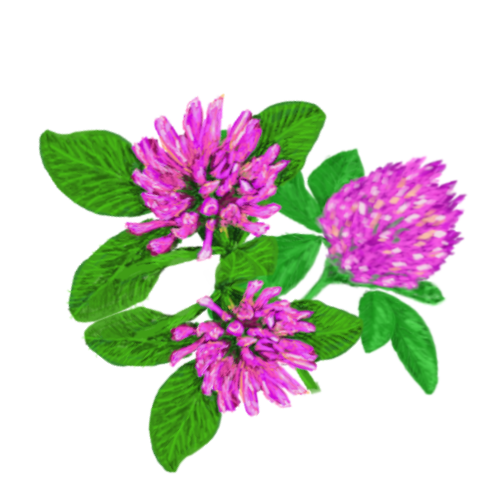
Also Known As
Trifolium pratense is known by many names –
- beebread
- trefoil
- cow grass
- marl grass
- wild clover
- meadow clover
- peavine clover
- purple clover
- honeysuckle clover
- broad-leafed clover
A native to Africa, Europe and Western Asia, she spread to England in the 17th century and was grown extensively as a nutritious forage crop for livestock. Cattle and horses love it. Later, she went with colonists to North America, where she naturalized widely. It’s no wonder she has so many names.
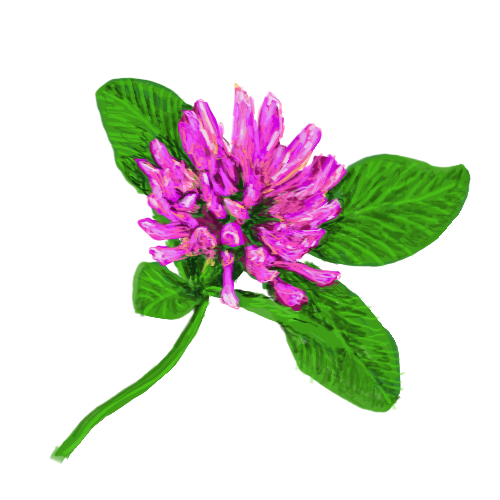
Food
Red clover is full of nutrition. The flowers are nutrient dense and contain the following –
- Calcium
- Chromium
- Magnesium
- Niacin
- Phosphorus
- Potassium
- Protein
- Thiamine
- Vitamin C
Nutritional and tastey, the entire plant can be eaten in salads, soups, stews or smoothies. It is excellent juiced. And can be steamed, sauted or eaten raw. Although for some, the raw plant may be difficult to digest. Soaking it for a few hours should help with this.
The dried flowers can be ground into an excellent and nutritious baking flour.
The seeds are great, too. Highly digestable, they are brimming with flavanols and antioxidants, which helps regulate blood pressure. They protect heart health by promoting better blood flow and, by extension, better transportation of oxygen and nutrients throughout the body.
They are very high in protein. 26% – which is a lot!
They also have a lot of otherwise hard to find essential vitamins and minerals such as –
- Zinc
- Phosphorus
- Vitamin K
- Vitamin E
- Vitamin A
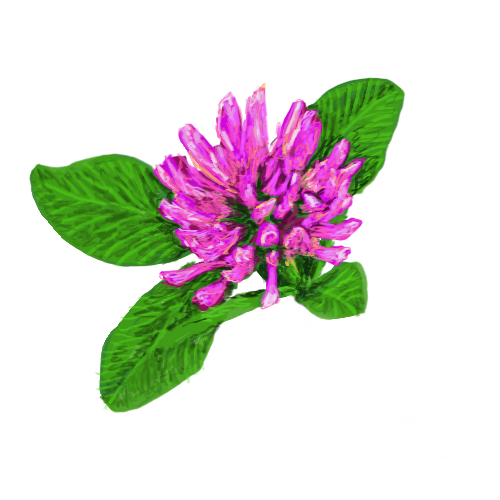
Medicine
Parts used: Flowering tops and leaves
Red clover is famous for dealing with “women’s problems.” This is because it contains isoflavones, which have similar effects as estrogen, making it a good way to ease the common difficulties related to estrogen loss –
- irregular periods
mood swings
irritation
nausea
hot flashes & night sweats
insomnia, fatigue
loss of libido
But it doesn’t stop there. Isoflavonoids also significantly increase bone mineral content, reducing the risk of developing postmenopausal osteoporosis. They prevent both cardiovascular problems and cognitive difficulties by reducing levels of triglycerides and increasing high-density lipoprotein cholesterol. They also improve skin elasticity, thickness, and hydration, which reduces wrinkles.
Not Just for Women
While the estrogen-like effects are specifically helpful for women, non-women can benefit enormously from red clover too. It has a huge healing potential for multiple systems of the body. For everybody.
Detoxifier
- efficiently removes metabolic wastes
- blood thinner
- removes accumulated toxins
- slightly diuretic,
- supports strong lymphatic flow
- relievies blocks in the lymphatic system
Respiratory issues
- chronic lung issues
- asthma
- expectorant and anti-spasmodic properties
- whooping cough
- bronchitis
- colds
Immune function
- fevers and inflammatory conditions
- debilitating illnesses
- hepatitis
- mononucleosis
Tonic for convalescents
- stimulates liver and gallbladder activity
- improvies appetite
- relievies constipation
- high levels of vitamins and minerals:
- vitamin B complex
- vitamin C
- calcium
- nitrogen
- iron
- chromium
- magnesium
- manganese
- niacin
- phosphorus
- potassium
- flavonoids
- saponins
- salicylates
- coumarins
- resins
- volatile oils
Skin disorders
- eczema
- psoriasis
- poultice for
- sores
- athlete’s foot
- rashes
- cancerous growths
Inflammatory conditions
- fomentation (application of soft, warm, medicinal substances for pain) of:
- rheumatic and arthritic joints
Nervine tonic
- mood balancer
- calms hysteria
- relieves stress
Cancer treatment & prevention
- prohibits the attachment and metastasis of abnormal cells
A note of caution
Whether eaten, made into tea or tinctured, Red Clover is super good for us. Be careful where you harvest it from, though. Seeing how it’s so good at absorbing minerals and nutrients from the soil, it also draws in pollution, pesticides and other toxins. So harvesting it from roadsides may not be a good idea. Grow it yourself, or find places where you can be reasonably sure it is not tainted.
Side effects of red clover
Red clover is very safe for regular use, for most people and can be taken frequently with no side effects. But because of the natural coumarins, it can have a blood thinning effect. So, it should be avoided by hemophiliacs or people taking pharmaceutical blood thinners, or drugs to prevent blood clots. Also, it should be stopped at least two weeks before having any surgery.
The isoflavones have a similar effect as estrogen, which means red clover may cause birth control pills to be less effective. Also: estrogen-sensitive cancers could be made worse.
Pregnant or breastfeeding women should consult their midwife, herbalist or lactation consultant before using it. Probably best not to – when in doubt, leave it out.

Wildlife
Honey bees prefer white clover, but bumble bees love it. Their long tongues can reach right down to the nectar and the long bloom period ensures a good, constant food source. Many types of butterflies are attracted to it. Song birds love to eat the seeds. It’s also a wonderful food for –
- quail
- grouse
- wild turkey
- partridge
- marmot
- deer
- woodchuck
- squirrels
- mice
- gophers
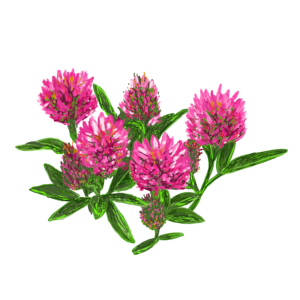
Lore – Magic – Spirituality
Red clover is steeped in long-standing mystical symbolism. In folkloric tradition, she is associated with protection, prosperity, luck and love. Carrying a red clover flower when signing contracts of any kind, ensures a good outcome.
Druids in the middle ages carried shamrocks, three-leaf clovers, as talismans to help them see evil spirits and, more importantly, ward them off. Out of that tradition, four-leaf clovers later became magical charms of protection and good luck. The Celtic Triskelion symbol is believed to have been inspired by the three leaf and is one of the primary symbols of Paganism.
There is a legend among the indigenous people of Virginia that the flowers of red clover sprang up from the blood of those slain in battle.
Medieval Europeans associated three-leaf with the Holy Trinity and a symbol of Salvation. According to an old legend, Eve took a four-leaf clover with her after she and Adam were expelled from The Garden. A four-leaf clover is a piece of Paradise to carry with you where ever you may go in life.
Red clover flowers are also believed to be a cure for heart-ache. Put them in a blue silk pouch and wear it near the heart. Newly-weds who carry clover in their shoes will have a long and happy marriage…and secretly putting clover sprigs in a traveling husband’s shoes ensures his faithfulness, regardless of how far he roams.
Sleeping with a four-leaf clover under your pillow will bring dreams of your beloved.
In folk magic, ritual baths steeped with red clover attract love and lust. And a flower in your shoe, will attract a new lover. A rich one!
White Clovers, however, are different. They’re about purity. They break hexes because they promote peace and clarity, which drives out negative energy. They’ve long been used in purification rituals. Drinking White Clover tea is said to enhance psychic powers.
But it’s not either/or. Why not have both!?!
In today’s world, we like to think we’re above this silly sort of belief system. But for those of us who are breaking the spell of the dominator culture, along with all it’s arrogant dismissiveness, it’s not far fetched at all. Look at all the wonderful “scientifically proven” properties of this plant. If you are a person who believes the planet is Alive, and part of a Living Universe, that has influence over everything, including your life, then how could the spirits of living plants not influence your life, as well?

Red Clover Recipes
Red Clover Tea
Fill a large pitcher or jar a quarter or so full, with fresh leaves and flowers. If dried, use half that. Pour boiling water up to the top. Let steep for 5 – 10 minutes and strain. Serve hot with honey or maple syrup.
Iced White Clover and Mint Tea
Combine equal parts white clover flowers and mint. 2 cups all together, if fresh, 1 cup all together if dried. Pour 4 cups boiling water over them and steep for at least half an hour. Can be left for up to 4 hours. Strain through cheesecloth or fine mesh sieve and refrigerate. Serve cold, over ice with honey or maple syrup and lemon.
Tincture
After washing, to remove any dirt or bugs, pack as many freshly harvested red clover flowers as you can into a jar. Pack them in as tightly as you can, nearly up to the top.
Fill the jar with vodka. Make sure the flowers are completely covered. Close with a tight fitting lid and put in a cool, dark place. Every few days give the jar a good shake. The color will drain from the flowers as the tincture matures.
After 4 weeks, drain the tincture through cheesecloth and wring it out good, making sure to get every drop. Bottle the tincture in glass bottles.
Red Clover Medicinal Vinegar Extract
Same as the tincture, but use Apple Cider Vinegar instead of vodka. Steep for 4 -6 weeks.
For menopause support, the dosage is 70 – 140 drops, 3 times a day. If counting drops is too tedious, call it a teaspoonfull, scant or brimming over. It doesn’t need to be precise. You can take it straight, put it in water or splash some on a salad.
Clover Blossom Flour
Harvest red and/or white clover blossoms. Together or separately, however you like.
Separate the leaves and flowers and dry separately in a sunny location, safe from cats, dogs and toddlers. The dried leaves will not be part of the flour. You can use them for other things.
It’ll take a few hours to dry out completely in the sun. If you have a dehydrator, use that.
The easiest way is to grind them in small batches, in a coffee grinder. You can use a food processor, but you still want to do it in small batches.
2 cups of dried blossoms will reduce down to about a ½ cup of flour. So, how ever much flour you want, you’ll need to harvest about 8 times that volume of fresh flowers.
It’s not flour, in the true sense. Having no gluten, it doesn’t hold together very well for baking, so you’ll want to mix it with another kind of flour. But it’s a lovely additive that imparts a mildly sweet, greeny flavor and a nice spongy texture.
Red Clover Gluten Free Muffins
1 medium egg, or vegan alternative
¼ cup red clover flour
¾ cup rice flour
3 Tablespoons sugar
½ teaspoon salt
2 teaspoons baking powder
2 Tablespoons high quality oil
large coffee cup full of fresh clover blossoms. for the infusion
optional confectioner’s sugar for topping
First make the infusion. Fill a large coffee cup with fresh clover blossoms. Pour boiling water over them and steep for 15 minutes. Strain and set aside.
Next, mix the dry ingredients together in a bowl.
Beat together the egg or egg replacement with ½ cup of the infusion.
Add the dry ingredients and mix well by hand or on low with a mixer.
Spoon batter into mini, medium or large muffin tins.
Bake at 400°F.
- 5 minutes for 24 mini muffins
- 10 – 12 minutes for 6 medium muffins
- 12 – 15 minutes for 4 large muffins
Muffins are done when a tooth pick inserted in the center comes out clean. Put muffin tins on a cookie sheet so as to not burn the bottom of the muffins.
Clever Clover Cookies
1 cup butter – or vegan substitute
1 1/4 cups brown sugar
1/2 cup granulated sugar
1 egg + 1 egg yolk – or vegan replacement
1 teaspoon pure vanilla extract
1 cup all purpose flour
1 cup white clover flour
1/2 teaspoon baking soda
1/2 teaspoon salt
1/4 teaspoon ground cinnamon
1 cup uncooked rolled oats
1 12 oz bag chocolate chips; white, dark or milk, whatever you prefer
You can replace and/or combine nuts and/or raisins with the chocolate chips. What ever combination you come up with, just keep it to 12 ounces, all together.
Preheat oven to 325°F. Cream together the butter/vegan replacement and both sugars. Once smooth, add the egg & egg yolk/vegan replacement, and the vanilla.
In a separate bowl, mix together all the dry ingredients, except for the chocolate chips/nuts/raisins.
Combine the wet and dry ingredients together until well blended. Fold in chocolate chips/nuts/raisins.
Scoop medium size balls of dough onto a cookie sheet (about 24). Bake for 12 to 14 minutes
Red Clover Biscuits
2 cups unbleached flour
1/2 cup almond flour
1 tbsp baking powder
1/3 cup butter at room temperature, or vegan substitute
2 eggs, beaten – or vegan substitute
1/2 cup plain almond milk yogurt
1/4 tsp vanilla extract
1 cup dried or fresh red clover flowers, broken up
2 Tablespoons ground flax meal – optional
Preheat oven to 350°F
Combine flour, almond flour, flax meal and baking powder in a bowl. Add butter/vegan replacement and knead until fully blended.
In a separate bowl, mix together the wet ingredients. Add in the broken up pieces of red clover flowers. Blend well.
Gradually mix both together, until completely blended.
Roll out dough on a lightly floured board to about ½” thick. Use a cookie cutter about 1½” in diameter and cut.
Bake on an ungreased baking sheet for 15 minutes or until golden brown.
Serve warm with jam or jelly.
Clover Blossom Jelly
You will need –
4 cups Clover Blossoms, stems & leaves removed
4 cups boiling bater
4 cups granulated sugar
¼ cup lemon Juice – fresh or bottled
1 3 oz. package of liquid pectin
Candy thermometer
First, make the blossom infusion –
- Prepare 4 cups of clover blossoms, trimming away green portions
- Rinse in a colander, shaking off excess water
- In a large saucepan, bring 4 cups of water to a boil
- Turn off the heat and add the flowers
- Make sure they are covered
- Put the lid on the pan and steep for about 45 minutes
- You can also let it steep over night in the refrigerator, for a more intense flavor.
Cook Clover-Blossom Jelly – About 20 Minutes
- Strain out the flowers
- Measure four cups of the infusion and return it to the saucepan
- Be sure to use an over-sized pan, as the mixture will rise when boiling
- Add lemon juice and sugar
- Turn heat to medium high, stirring constantly
- Attach the candy thermometer to the side of the pan
- Stir constantly until the infusion reaches the gel point
- see gel point temperature by altitude, below
- Bring it to a hard boil that won’t stir down
- Add pectin and boil for two more minutes
- Reduce heat as needed, to avoid boiling over.
Gel Point by Altitude
| Sea level to 1000 feet | 220°F |
| 1001 – 2000 feet | 218°F |
| 2001 – 3000 feet | 216°F |
| 3001 – 4000 feet | 214°F |
| 4001 – 5000 feet | 212°F |
| 5001 – 6000 feet | 210°F |
| 6001 – 7000 feet | 208°F |
Pour into 6 half pint jars with ¼ inch head space if you’re planning on canning it.
Optional Water-Bath Canning Instructions
- Ladle jelly into hot jars, leaving 1/4″ headspace
- Screw on 2-part canning lids
- Place jars in a water-bath canner
- Covered by at least 1 inch of water
- Boil for 5 minutes
- Remove jars onto a towel, out of drafts
- Allow to cool for 24 hours
- Test the lids to make sure the jars are properly sealed
Get beautiful merch with my hand drawn designs!





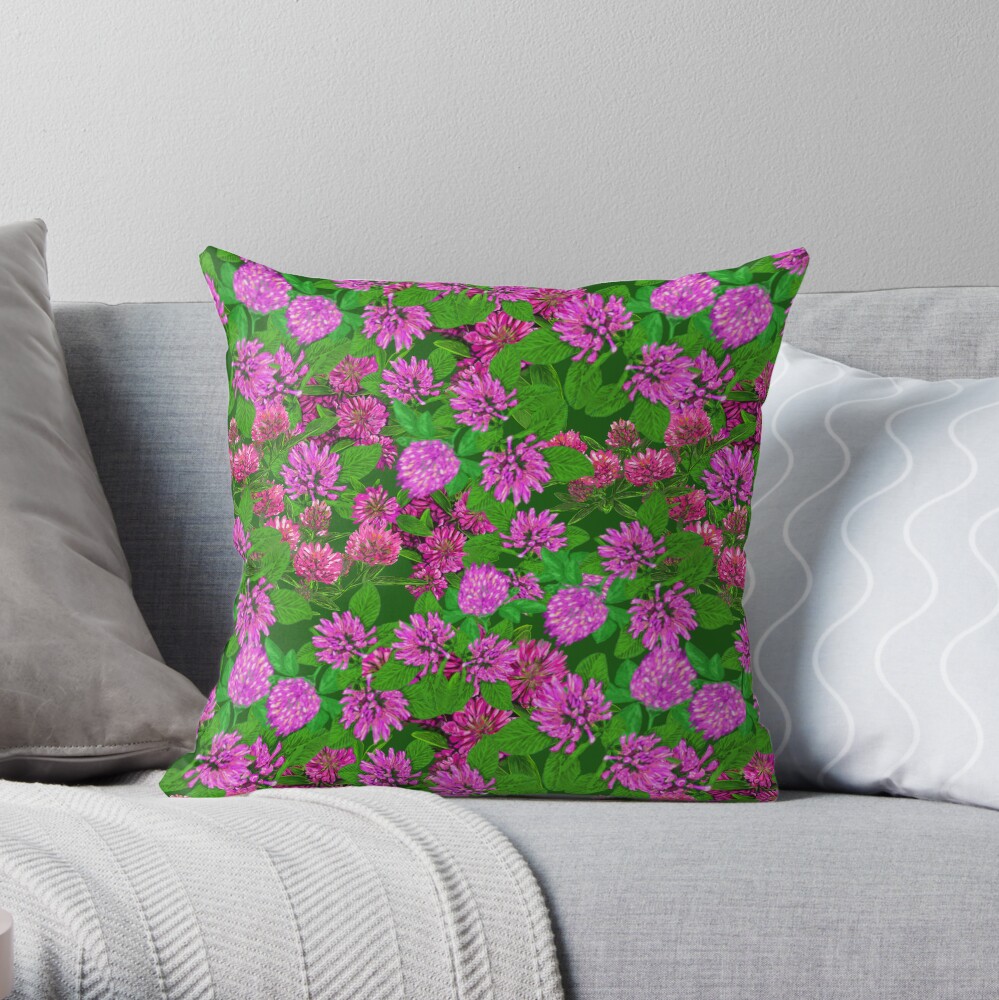





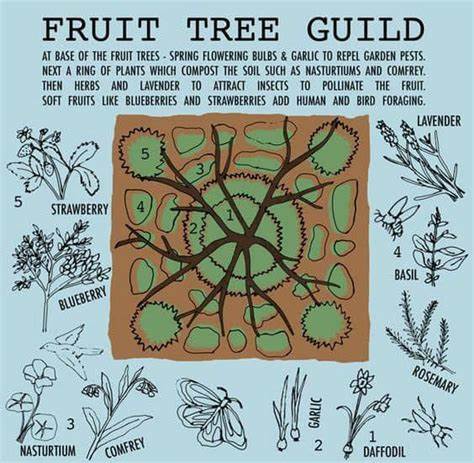
I love the victorian era and learning about how flowers made statements is totally awesome. I guess that was why they always thought about what they were saying and were very conscientious about the things they sent. That makes so much more sense. Thank you for such an insightful article about how this little plant says so much!
Thanks, Mamabear
There’s a cool Druidic language that involves stringing together various leaves. Each has a particular meaning and the order they’re strung together means something, too. Apparently this was how they told others about stuff going on the in forest. It’s something I want to look into further.
Anna
The article is a comprehensive guide to red clover, covering everything from its history and uses to its cultivation and harvesting. You provide a wealth of information on this versatile and beneficial plant, making it an excellent resource for anyone interested in incorporating red clover into their homesteading or gardening practices.
The article includes detailed instructions on how to grow red clover, including the best soil conditions and planting methods. You also discuss the many benefits of red clovers, such as their ability to improve soil fertility and attract beneficial insects.
I appreciate the Your attention to detail and your thorough exploration of the many uses and benefits of red clover. The article is well-written and engaging, making it an enjoyable read for anyone interested in gardening or homesteading.
Overall, “A Red Clover Compendium” is an excellent resource for anyone looking to learn more about this versatile and beneficial plant. Your passion for the subject shines through in your writing, and the article serves as a valuable guide for those looking to incorporate red clover into their homesteading or gardening practices. I highly recommend this article to anyone interested in gardening or homesteading.
Thank you so much for your thoughtful and appreciative comment. It means a lot to me.
And, I have to admit, I had a lot of fun putting it together. At first, I was trying to be too sciencey. And it felt like a drudgery, that I dreaded to face. Because that’s just not who I am. Once I incorporated the magic, lore, recipes and flower language stuff, it all turned around. Suddenly, I was as happy and excited to get back to working on it as I could possibly have been.
This blog is still new. And the process of finding my voice…in this new context of writing a blog… has been my main problem to solve. I didn’t realize that, of course, until I solved it. But now that I have, by writing this, I’m super excited to do the same thing with all the other plants on my long list.
After about 20 years of non-stop writing, I should have a great Encyclopedia!
😀
Anna
Very good article abaut Red clover i love this medicinial plant my gandmother uset in tea and biscuit is very pawer and very good auto-oxidant with vitamin c, mangnezium, proteine e too many beneffit . Thank you for share this is very helpful and intersant to now haw many speaces are and dhe history . People should now more that the plant are life
Hey Anna-Vita,
I loved your article on Red Clover and its intriguing aspects. It’s fascinating how its Latin name, “Trifolium pratense,” can mean both “three leaf growing in meadows” and “three leaf speaking.” Red Clover’s versatility as a nitrogen fixer and its impact on soil health is remarkable. Its associations with protection, luck, and love in folklore and spirituality add an extra layer of mystique. Thanks for sharing the captivating world of Red Clover!
Best regards,
Israel
Hi Israel
Yes. Red Clover is a miracle plant. I too, love the lore, magic and mysticism aspects of plants. It’s so much more satisfying to me than nothing but the dry scientific view. I mean, the scientific studies provide us with some incredible information. But the lore is so much more fun! And humanizing. And Latin names aren’t as “scientific” as people always assume. 😀
Thanks for stopping by,
xxoo,
Anna
Anna-Vita –
Wow! This article was enlightening, educational, and beautifully written. The red clover has a plethora of medical benefits which I was unaware of until now. One that stands out is being a detoxifier. Removing toxins or metabolic waste enables you to feel more vibrant.
I like how you added the note of caution red clover that is home grown is best. Does red clover grow best in the cooler weather? In other words, what climate does it thrive in?
Hi Godwin
Thanks for stopping by. Yes, Red Clover is rather amazing. Being a nutrient accumulator, she will also accumulate toxins, so harvesting plants you know are ok, be they from your own property or other places is important. Red Clover grows pretty much everywhere. Probably not on the North or South Poles,,,
What a great article on clovers! I never thought it was such a powerful plant. I will definitely try some of the recipes you listed here. Furthermore, I was also fascinated reading that Red Clover was famous for dealing with “women’s problems” and that isoflavones had similar effects as estrogen. Very interesting article where your passion shined throughout!
Thanks for your nice comment, Joanne
Yes, I am passionate about it. And I learned a lot writing this article, too. I mean, I’ve known that Clover is amazing for a pretty long time, but I never realized the extent of her wonderfulness. Was really exciting for me to write this.
Anna
These red clover flowers are so versatile. From being decorative, to being eaten and an important ingredient for different kinds of food, wow!
I’m overwhelmed with what they can do. Plus being medicinal.
They look so nice and beautiful, too!
Are they those that look like buttons on top of their green leaves?
I think I see them on the sidewalk in the bridge that I walk to work and from work.
Marita
Hi Marita
They are beautiful, aren’t they?! And I’m sure they are what you’re seeing on your walk to work…they’re everywhere!